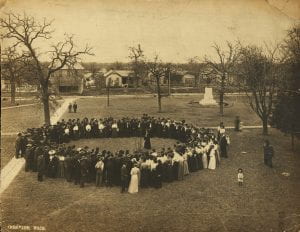This piece by former Texas Collection director Kent Keeth was originally published in The Baylor Line in February 1980. Blogging About Texas periodically features selections from Looking Back at Baylor, with hopes of sharing Keeth’s work with a new audience.
**In honor of Arbor Day, read about Baylor’s early tradition of planting trees to beautify campus as well as mark the passage of campus traditions from one class to the next. **
At the turn of the century, Texas’ official observance of Arbor Day occurred on February 22, in conjunction with the state’s commemoration of George Washington’s birthday. On Baylor’s campus, however, students selected a different presidential milestone with which to combine the annual event. Beginning in 1903, seventeen successive senior classes marked December 4, President Samuel Palmer Brooks’s birthday, by a ritual known as “tree-planting” on Burleson Quadrangle.

Brooks had assumed Baylor’s presidency in June 1902. By the time of his fortieth birthday, eighteen months later, he had won the admiration and respect of the university’s students to such an extent that the seniors chose this occasion to honor him with their symbolic contribution to their alma mater.
Burleson Quadrangle, in every sense the focal point of the campus, had been completed by the dedication of Carroll Science Hall and Carroll Chapel and Library earlier in the year. The students had sought a project which would make the university’s grounds even more beautiful.
The agenda of the first tree-planting, as reported in the Lariat, set a pattern for years to come. Seniors, garbed for the first time in their caps and gowns, solemnly paraded in pairs to the selected location. They were followed by members of the junior class, who joined them in forming a circle around the site. Following the invocation, a poem and a song which had been composed for the occasion were read and sung, and the senior class roll was called and answered with humorous responses.
The presidents of the two classes saluted one another in carefully worded speeches of jocular challenge and, the tree was placed into the ground, each of the seniors scooped a spadeful of dirt around its roots. After President Brooks had accepted the seniors’ gift on behalf of the university, the spade was handed over to the junior class president for use in similar ceremonies the following year. Then, with eyes moist but spirits high, all participants adjourned to the annual senior- junior football contest on adjacent Carroll Field.
While the broad outlines of the tree-planting ceremonies remained constant, the passage of years saw the addition of new features. By the nineteen-teens, seniors had begun to place more than shovelfuls of earth around the base of their tree. In a 1976 interview Dr. Cornelia M. Smith (BA ’18), retired chairman of the biology department, recalled the 1914 ceremony which she had witnessed as a student: “The climax of the program was reached at the roll call of the class. Each member responded by burying some words of condemnation at the foot of the tree, the things that he or she most detested about Baylor. Some of the burials brought good results, as for instance the abolition of chapel examinations. Can you imagine? Chapel examinations!”
Other buried grievances itemized by the Lariat included final examinations, the campus’ inaccurate system of clocks, certain areas of much- patched linoleum flooring, “sickening campus spooners,” and the rats in Burleson Hall.

Perhaps Baylor’s students during the 1920s grew too sophisticated for the continuation of such a simple and rustic tradition: or perhaps, after seventeen years, Burleson Quadrangle was becoming so thickly wooded that no available sites remained for further implantations. Whatever the reason, the annual tree-plantings were discontinued after 1919.
In any case, with the construction of the new heating plant near Waco Creek in 1920, and of Brooks Hall at the northern extreme of the campus in 1921, Baylor’s horizons were beginning to expand beyond the confines of the Quadrangle. Future generations of students would move within a greatly expanded sphere of activity, while continuing to enjoy the shaded and leafy inheritance bequeathed to them by their predecessors.
**Ring Out and Passing of the Key, established in 1927 and 1946, respectively, accomplish the same intent as tree-planting; recognizing and passing on the knowledge and traditions of the university from one class to the next. Similarly, the Freshman Class Hymn, established in 2008, also fulfills the sentiments of tree-planting. The first ceremony included an original poem and song composed for the event.**
No Comments